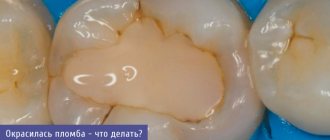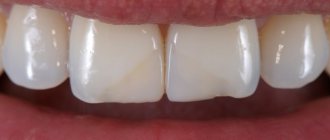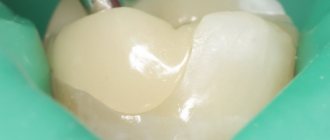A photopolymer filling is a modern filling material based on a composite substance that changes its state of aggregation under the influence of light rays of a certain length. Light composite has a whole range of advantages over traditional analogues, including: increased strength, durability, resistance to pigmentation, comfort of work for the dentist, etc.
After hardening of the photopolymer composite, the filling is reliably connected to natural dental tissues and acquires maximum strength. It is installed in the treatment of a wide range of dental pathologies and is the most popular solution in modern dentistry.
What is a photopolymer filling?
Photopolymer filling is a popular and convenient way to restore teeth, which uses photopolymer materials.
Photopolymer fillings are considered the most reliable for dental restoration. Thanks to different shades and degrees of transparency, they can be installed on darkened elements and metal.
Complete restoration of all functions of the jaw apparatus does not cause discomfort to the patient.
Composites harden in the oral cavity solely under the influence of a specific wave of light emanating from a lamp. Thanks to this property, the dentist can do his work slowly and creatively.
Most composite materials for dental fillings contain Bisphenol A.
The chemical component negatively affects the health of patients suffering from endocrinological diseases.A small amount of Bisphenol is detected in saliva even if only 2-3 fillings are installed.
Dental surgeon, periodontist
Tevs Maria Konstantinovna
7 years experience
In addition, light-reflecting composites are available in different colors and degrees of transparency, and accordingly, with their help it is possible to hide darkened hard tissues and even metal, as well as restore enamel and dentin.
Toothache after temporary filling
Penetration of infection deep into the hidden layers of teeth inevitably entails treatment associated with the removal of damaged tissue and nerve endings.
There is also technology that allows you to combine reflective and chemical materials. It is in this case that it is possible to make the most of all the advantages and neutralize the disadvantages of each method.
There are many reasons why photopolymer fillings are widely used in dentistry. The risk of cracks occurring during operation is minimized. All functions of the teeth are completely restored, while the patient’s sensations remain the same as with healthy teeth.
Reviews
“A light-curing filling is a real salvation! She helped me get rid of a terrible huge hole in my tooth, which constantly hurt when any food got into it. It is worth noting that the procedure is quite quick; I spent no more than 30 minutes with the doctor. No pain! I’ve been using it for almost 2 years now, I eat almost everything, but it still stands and hasn’t even changed color!”
Karina, 43 years old
“I have always been skeptical about any innovations and innovations in domestic medicine. I found out about light filling and decided to try it. There was very little money, so I went to the clinic at my place of residence. Everything was interesting, the doctor constantly shined “his flashlight” into my mouth. However, the procedure did not take much time, and they charged me only 600 rubles (this type of filling is not included in the compulsory medical insurance policy). It’s been 4 months now and there seem to be no problems.”
Marina, 29 years old
My son constantly has toothache (he is 23). He advised me to go to a dentist I know and get a light filling; the usual ones quickly crumbled and did not last for more than six months. He went and immediately put 3. Now, at every meeting, he thanks me, says that they are excellent, he even stopped being afraid of eating nuts.”
Gennady, 52 years old
Kinds
Regardless of the type, a composite material is used to make a photopolymer filling. He can be:
- macro-filled;
- microfilled;
- minifilled;
- hybrid;
- compomer.
In addition, composites are divided into fluid and solid. They are placed in syringes and applied to the surface to be treated using tools specially designed for this purpose. Conventional ones are not suitable for this purpose, as the material will stick to them.
In case of restoration of the interdental contact point, as well as when filling the cervical area, they resort to the use of fluid polymer fillings.
It is they that fit as tightly as possible and are evenly distributed over the surface, due to which they create tight contact with hard tissues. They are easy to use. In this case, the possibility of applying more composite than necessary is completely excluded.
Toothache after filling
Painful sensations after tooth filling is a problem that occurs in 80% of patients.
In the process of restoration of anterior teeth, it is customary to use solid photopolymers. They are plastic, thanks to which they can give the tooth any shape and will fully correspond to the anatomical structure.
When restoring a large cavity, the material is applied in layers, since the rays of the lamp cannot penetrate into the deep layers. For more reliable fixation, the enamel is highlighted first and only then the remaining areas.
How much does a filling cost?
In Moscow, prices for the simplest products start at 400 rubles. Composite fillings can cost up to 2 thousand rubles apiece. Ceramic inlays are the most expensive, since they are more related to microprosthetics. The price of the product depends not even on the material, but on the complexity of the shape of the filling and the time spent on manufacturing. The more complex the work, the higher the cost.
In public clinics, fillings are performed free of charge. Only the most affordable cement materials are used. If you want a higher quality product, you will have to pay extra.
Everyone will have to deal with a filling at least once, so this information will be useful to everyone. If you don’t know what dental fillings are, you simply won’t be able to choose the best option for yourself.
Indications and contraindications
There are a number of indications for which the use of photopolymer materials is used. The main ones:
- tooth fracture;
- change in color of enamel that cannot be bleached:
- significant defects of tooth enamel;
- the presence of large fillings in the cervical area;
- noticeable interdental gaps;
- the need for minor correction of the position of the teeth;
- damage to the crown by a maximum of forty percent.
Even if there are indications for installing a filling, a specialist may refuse to carry out the necessary treatment. Among the main contraindications for installation are the following:
- bruxism;
- severe destruction of the front teeth;
- active development of caries;
- teeth subjected to intensive fluoride treatment;
- lack of proper oral hygiene.
Some of the contraindications are classified as conditional. Over time, they can be eliminated, and, accordingly, there will no longer be barriers to installing fillings made of photopolymer materials.
Conventional chemical
The main difference between a simple (chemical) filling and a light filling is how they harden. A regular filling becomes hard due to a chemical reaction that occurs when different types of filling material are mixed. The result is a consistency with the required density and elasticity.
Dentists typically use two types of conventional chemical fillings:
- Composite - it contains several different chemical ingredients, which, when hardened, can differ significantly from the natural color of tooth enamel. The material hardens evenly, but does not last long - usually about 2 years.
- Glass ionomer - contains a special liquid and powder, which are mixed in the required proportion.
The composition hardens due to an acid reaction. Dentists can add additional components to this mixture as needed. Attention! Glass ionomer filling is good because it has the ability to release fluoride, which serves as a preventive measure against the re-development of caries.
Installation
The process of installing a photopolymer filling is carried out in several stages. Most often, treatment is carried out according to this plan:
- Administration anesthetic drug.
- Preparation of the area affected by caries.
- Treatment with medications.
- Isolation of saliva and mandatory drying.
- Application of acid to improve adhesion.
- Thorough rinsing and drying.
- Application of adhesive material.
- Layer-by-layer application of the composite.
- Polishing and grinding.
If the depth of the lesion is too great, then additionally resort to the use of a therapeutic and insulating pad. If dentin layers are damaged, they must be isolated. In those cases when the cavity is excessively large, first a medicinal material is placed into it and only then an insulating material.
Why can our articles be trusted?
We make health information clear, accessible and relevant.
- All articles are checked by practicing doctors.
- We take scientific literature and the latest research as a basis.
- We publish detailed articles that answer all questions.
The process of etching the enamel can be carried out both before and after insulation. The gel, which contains orthophosphoric acid, is applied exclusively to the dried surface. Only in this case will it be possible to achieve the desired effect.
After applying the adhesive system, it is sprayed using an air stream. Then the material is illuminated with a lamp for literally half a minute. The filling is formed by layer-by-layer application of reflective material.
At the final stage of installation, the filling is ground, removing all irregularities and polished. The tooth acquires natural smoothness and shine. It is almost impossible to distinguish it from natural one.
What does the cost depend on?
Everyone probably knows that treatment and installation of a filling is quite expensive. This depends on many factors that the doctor takes into account when determining the total cost. Typically, when treating and installing a filling product, the following important components are used:
- Expensive medicinal materials;
- High-quality filling compounds;
- Use of expensive equipment;
- Highly professional dentist.
Therefore, you should not be surprised that comfortable treatment, infection and filling of teeth will cost a tidy sum. However, the cost may differ each time. Sometimes you can cure a tooth in just one visit, and sometimes several visits may be required, and the cost will vary significantly. In addition, the cost depends on the stages of treatment. Typically, all dental clinics have a standard list of treatment stages, which includes the following services:
- Initial examination;
- Cleansing the affected area;
- Administration of the drug;
- If the need suddenly arises, an X-ray examination is required, in which a photograph of the tooth roots is taken;
- Carrying out cleaning and formation of channels;
- Removal of nerves;
- Canal filling;
- Installation of a temporary filling;
- Installation of a permanent filling.
The cost of all these services can be found in clinic price lists. In addition, the cost may vary depending on the type of filling. Fillings made from a composite or luminous material will be much more expensive than simple cement or plastic products.
Care
The rules for caring for photopolymer fillings are practically no different from ordinary oral hygiene.
Toothache after filling when biting
Most people monitor the health of their teeth and promptly contact the dentist at the first negative signs.
Patients simply need to brush their teeth regularly with a soft toothbrush and rinse their mouth with warm water or a special solution after each meal.
It is also important to regularly, at least once every six months, have a routine examination with a dentist. Only if problems are detected in a timely manner can they be easily eliminated and the development of more serious diseases prevented, and accordingly preserve the integrity of the tooth that has been restored.
Alternatives
There can be two alternatives for restorations:
- Removal and installation of a dental crown made of ceramics or metal-ceramics.
- Inlays instead of fillings. They are more expensive, but have a long service life and are also very reliable.
Photo of a dental inlay and crown
In conclusion, we can conclude that all types of fillings for restoration after caries are different and, accordingly, have different service lives. It’s better, of course, to spare no expense and get a good filling done once, than to go to the dentist every six months and get a new restoration done. Regarding the need for such a procedure, the patient must understand that the teeth must be not only healthy, but also beautiful, and therefore they cannot do without restoration after treatment.
The fillings do not require special care; you just need to follow the usual rules of hygiene and then caries will leave you forever. If we take into account all the pros and cons, then restoration with any types of fillings is the best solution after caries treatment.
Life time
The service life of photopolymer fillings largely depends on the quality of the material and the competence of the specialist. In addition, the patient himself is able to both shorten and significantly extend the service life of the filling.
The materials used in the filling process can be either highly durable or less reliable. Provided that a high-quality composite is used, it can last up to seven years.
There are cases when the filling falls out almost immediately after its installation. There may be several reasons for this. It is possible that when filling, the doctor made a mistake, as a result of which the material was not securely fixed. The most common cause is adhesion failure due to saliva or liquid.
Filling falling out
Dental treatment often takes a long time.
In such cases a guarantee is issued. Within a year after the filling is installed, the patient can apply for a repeat procedure. There is no charge for the service.
It is also possible that the patient simply did not follow all medical recommendations. In this case, you also need to seek help from a specialist. It is advisable to give preference to those clinics that have only positive recommendations. In this case, the risk of the filling falling out will be minimal.
Answers to frequently asked questions from patients
How long does the filling last?
On average 5-7 years. The warranty on them is given from six months to a year (taking into account the manufacturer and quality of workmanship).
How soon can you eat?
We recommend that you refrain from eating for an hour after filling.
Which filling is preferable - chemical or light?
In terms of strength and durability, light-curing fillings are superior to chemical ones. But the latter contains fluoride, which strengthens the internal tissues of the crown.
Do's and don'ts after installation
When installing light fillings, the doctor gives a number of recommendations, following which it is possible to preserve their integrity for many years. The most important of them are the following:
- Eliminate viscous foods from the diet that can lead to loss of the composite.
- Avoid excessively hard foods such as nuts and crackers, especially in cases where the front teeth have been restored.
- Get rid of the habit of biting your nails and biting threads.
- Brush regularly, at least twice a day .
- professionally once every six months . In this case, be sure to inform the specialist that photopolymer fillings have been installed and indicate their exact location.
- For several days after the filling is installed, do not eat foods that contain dyes. Otherwise, the material will darken and the tooth will lose its natural appearance.
The main advantage of fillings made from photopolymer materials is that you can eat food immediately after the procedure. If chemicals are used, it is necessary to wait at least two hours for the cement to completely harden.
Materials
The filling mixtures include environmentally friendly components that are safe for human health:
- polymer matrix (thanks to blue light waves with a length of 450 nanometers, it hardens);
- filler (barium glass particles, glass ceramics, silicon dioxide, etc.);
- a binding agent (for example, silanes - compounds of hydrogen and silicon).
Most often, composites from the following manufacturers are used for light fillings:
- Fuji (Japan);
- Noritake (Japan);
- Kerr (USA);
- Dipol (USA);
- Bisco (USA);
- GC America (USA);
- Degussa (Germany).
Photopolymer from the American company Kerr
Advantages and disadvantages
The demand for photopolymer fillings is due to a number of their advantages. The main ones are the following:
- it is possible to accurately restore the relief and shape of teeth even in cases where they are too damaged;
- the filling is combined with hard tissue into a single whole thanks to a special adhesive system;
- after hardening, the material becomes durable, securely bonded to the enamel, and resistant to cracking;
- it is possible to achieve the desired cosmetic effect by selecting the desired color shade of the material;
- installation is carried out by applying the composite layer by layer, thereby creating an imitation of natural dental tissues;
- preparation of cavities and defects is reduced to a minimum;
- In case of delamination or chipping, adhesive correction is possible.
Among the disadvantages of such fillings, one can highlight only shrinkage of the composite when exposed to light and insufficient polymerization. The polymer does not harden completely, and therefore the original shade may change over time.
Photopolymer fillings have many advantages, which is why they are most often used in dentistry. This is a reliable type of dental restoration, with the help of which it is possible to give even severely damaged hard tissues a natural appearance.
Another peculiarity of the use of light composites is that the material hardens only under the influence of a special lamp. Accordingly, the specialist has the opportunity to clearly recreate the natural shape of the tooth, which is very difficult when using other materials.











